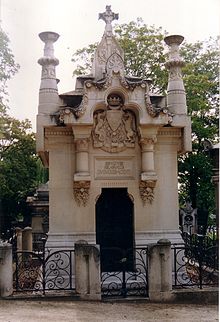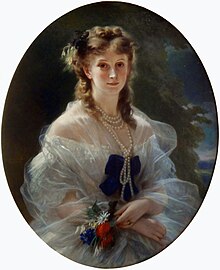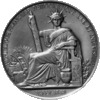Charles, Duc de Morny
Charles de Morny | |
|---|---|
| Duc de Morny | |
 | |
| Born | 15 September 1811 |
| Died | 10 March 1865 (aged 53) |
| Spouse(s) | Princess Sofia Sergeyevna Trubetskaya |
| Issue | Marie Eugenie de Morny, Countess of La Corzana Auguste Charles, 2e Duc de Morny Serge de Morny Sophie de Morny |
| Parents | Charles Joseph de Flahaut Hortense de Beauharnais |
Charles Auguste Louis Joseph Demorny/de Morny, 1er Duc de Morny [ʃaʁl oɡyst lwi ʒɔzɛf dəmɔʁni] (15–16 September 1811, Switzerland – 10 March 1865, Paris) was a French statesman.
Biography
Morny was born in Switzerland,[1] and was the extra-marital son of Hortense de Beauharnais (the wife of Louis Bonaparte and queen of Holland) and Charles Joseph, Comte de Flahaut, making him half-brother of Emperor Napoleon III and grandson of Talleyrand. His birth was duly registered in a misleading certificate, which made him the legitimate son of Auguste Jean Hyacinthe Demorny, and born in Paris on 23 October 1811,[2]</ref> and described as a landowner of St. Domingo. M. Demorny was in fact an officer in the Prussian army and a native of St. Domingo, though he owned no land there or elsewhere.[3]
Morny was educated by his grandmother, Adelaïde Filleul.[citation needed] After a brilliant school and college career the future duc de Morny received a commission in the army, and the next year he entered the staff college. The comte de Morny, as he was called by a polite fiction, served in Algeria in 1834–1835 as aide-de-camp to General Camille Alphonse Trezel, whose life he saved under the walls of Constantine.[3]

When Morny returned to Paris in 1838, he secured a solid position in the business world by establishing of a major beet-sugar industry at Clermont-Ferrand in the Auvergne and by writing a pamphlet Sur la question des sucres in 1838. In these and other lucrative speculations he was helped by his mistress Françoise Mosselman, the beautiful and wealthy wife of the Belgian ambassador, Charles Aimé Joseph Le Hon, Comte Le Hon. Eventually there were few great commercial enterprises in Paris in which he did not have an interest.[3]
Although Morny sat as deputy for Clermont-Ferrand from 1842 onwards, he took at first no important part in party politics, but he was heard with respect on industrial and financial questions. He supported the government of Louis Philippe, because revolution threatened his commercial interests, but before the Revolutions of 1848, by which he was temporarily ruined, he considered converting to the Bourbon legitimist cause represented by the Comte de Chambord. His attitude was expressed by the witticism with which he is said to have replied to a lady who asked what he would do if the Chamber were "swept out." "Range myself on the side of the broom handle," was his answer. Presently he was admitted to the intimate circle of his half-brother Louis Napoleon, and he helped to engineer the coup d'état of 2 December 1851 on the morrow of which he was appointed to head the ministry of the interior.[3]

After six months in office, during which Morny showed his political opponents moderation and tact, he resigned his portfolio, ostensibly because he disapproved of the confiscation of the Bourbon-Orléans property but really because Napoleon, influenced by Morny's rivals, resented his claim to a foremost place in the government as a member of the Bonaparte family. He then resumed his financial speculations. When in 1854 the Emperor appointed him president of the Corps Législatif, a position which he filled for the rest of his life, he used his official rank to assist his schemes.[3]
In 1856, Morny was sent as special envoy to the coronation of Alexander II of Russia and brought home a wife, [[, Princess Sophie Troubetzkoi, who through her connections greatly strengthened his social position. Sophie was legally daughter of Prince Sergey Vasilyevich Trubetskoy, but may have been the illegitimate daughter of Nicholas I of Russia. In 1862, Morny was created a Duke. It is said that he aspired to the throne of Mexico, and that the French expedition sent to place Archduke Maximilian on the throne was prompted by Napoleon III's desire to thwart this ambition.[3]

In spite of occasional disagreements, Morny's influence with the emperor remained great, and the liberal policies which he advocated enabled him to serve the imperial cause through his influence with the leaders of the opposition, the most conspicuous of whom, Émile Ollivier, was detached from his colleagues by Morny's efforts. But while he was laying the foundations of the "Liberal Empire" his health deteriorated and was further injured by quack medicines. The emperor and the empress visited him just before his death in Paris on 10 March 1865.[3]
Morny's valuable collection of pictures, including Jean-Honoré Fragonard's The Swing, was sold after his death. In spite of his undoubted wit and social gifts, Morny failed to secure the distinction he desired as a dramatist, and none of his pieces, which appeared under the pseudonym of M. de St Rémy, including Sur la grande route, M. Choufleuri restera chez lui le . . ., and the Les finesses du mari, among others, met with success on the stage.[3]
Thoroughbred horse racing
Morny played an important role in the development of the thoroughbred horse racing and breeding industry in France. In 1860, he purchased the English Triple Crown champion West Australian and brought him to France for breeding purposes. In 1862 Morny built the Deauville-La Touques Race Course near Deauville. The Prix Morny is named in his honour.[citation needed]
Contribution to French Orientalism
In 1832, the Count took the French Romantic painter Eugène Delacroix with him on a diplomatic mission to Tangier, exposing the artist to life outside of cloudy, overcast Paris.[4] Over the course of his six months in North Africa, Delacroix executed a number of pencil and watercolor sketches in seven notebooks, depicting the Moroccan architecture, landscape, and people, which served as artistic inspiration for the remainder of his career.[5]
Family

whom he had married at St. Petersburg on 7 January 1857, Princess Sofia Sergeyevna Trubetskaya (Moscow, 25 March 1836 – 8 August 1896), the only daughter of Prince Sergey Vasilyevich Trubetskoy (1814 – 12 May (30 April Old Style), 1859) and his wife Ekaterina Petrovna Mussina-Pushkina (1 February 1816 – c. 1897). Their children included:
- Marie Eugenie de Morny (1857–1883), who married a Spanish noble, José Ramón Gil Francisco de Borja Nicolás Osório y de Heredia, 9th Conde de La Corzana (1854 – 1919), in 1877 in Madrid, and had a son:
- José Osorio y de Morny, 10th Conde de La Corzana (Madrid, 1878 – Madrid, 1919). He married María de la Purificación Dorticos-Marín y León, Marquesa de Marín (1878 – 1928), in 1902 in Madrid. He had no children.
- Auguste Charles Louis Valentin de Morny (1859–1920), who succeeded his father as the 2nd Duc de Morny. He married Carlota de Guzmán-Blanco y de Ybarra (Caracas, 1869 – Courbevoie, 1939) in 1886 in Paris and had three children:
- Auguste de Morny, 3rd Duc de Morny (1889–1935), unmarried and without issue.
- Antoine de Morny, 4th Duc de Morny (1896–1943), unmarried and without issue.
- Anna Teresa de Morny (1890–1924), unmarried and without issue.
- Serge de Morny (1861–1922), who died unmarried and without issue.
- Sophie Mathilde (Missy) de Morny (1863 – 1944), who married Jacques Godart Marquis de Belbeuf (1850 – 1906) in 1881 in Madrid and divorced him in 1903; without issue.
Theatrical interests
De Morny was influential in the early career of Sarah Bernhardt. In her autobiography, My Double Life, Bernhardt recounts that at a family conference which de Morny attended as a family friend, the purpose of which was to determine what Bernhardt was to do with her future life, de Morny suggested that she be sent to the Conservatoire. The family took him up on the suggestion and her life turned to the theatre.[6]
Notes
- ^ Mossiker 1964, pp. 361–362.
- ^ Le Guide Musical 1865.
- ^ a b c d e f g h Chisholm 1911, p. 849.
- ^ Chu 2012, pp. 217–219.
- ^ Rosenthal 1982, p. [page needed].
- ^ My Double Life, London: Heineman, 1907, p. 52-58
References

- Chu, Petra ten-Doesschate (2012). Nineteenth-Century European Art (3rd ed.). London: Laurence King Publishing. pp. 217–219.
{{cite book}}: Invalid|ref=harv(help) - "Issue 11, 16 March 1865 Nécrologie (Obituaries) p. 4". Le Guide Musical. Schott. 16 March 1865. Retrieved May 8, 2009.
- Mossiker, Frances (1964). Napoleon and Josephine: The Biography of a Marriage. New York: Simon and Schuster.
{{cite book}}: Invalid|ref=harv(help) - Rosenthal, Donald A. (1982). Orientalism, the Near East in French painting, 1800-1880. University of Rochester.
{{cite book}}: Invalid|ref=harv(help)
Attribution:
- This article incorporates text from a publication now in the public domain: Chisholm, Hugh, ed. (1911). "Morny, Charles Auguste Louis Joseph, Duc de". Encyclopædia Britannica. Vol. 18 (11th ed.). Cambridge University Press. p. 849–850.. Endnotes:
- H. Castille, M. de Morny (1859), an Arthur de la Guéronniére, Etudes et portraits politique.; (1856).
- See the literature dealing with Napoleon III., and the article on Flahaut de la Billarderie;
- F. Loliée, Le Duc de Momy, adapted by B. O'Donnell. A volume, Extraits des mémoires de Alamy: Une Ambassade eh Russie 1856, was published in 1892.
- The figure of the duc de Morny appears in the novel Duc de Mora of Le Nabab by Alphonse Daudet (1877, English: The Nabob, 1878) — Daudet had been one of Morny's secretaries.
Further reading
- Benstock, Shari (1986). Women of the Left Bank: Paris, 1900—1940. Austin, Tx.: University of Texas Press. ISBN 0-292-79040-6.
- Williams, Roger L. (1957). "Chapter II: The Duc de Mornay and the Genesis of Parliamentarianism". Gaslight and Shadow: The World of Napoleon III. New York: Macmillan.
External links
- Free scores by Charles, Duc de Morny at the International Music Score Library Project (IMSLP)
- Coat of arms (in French)

